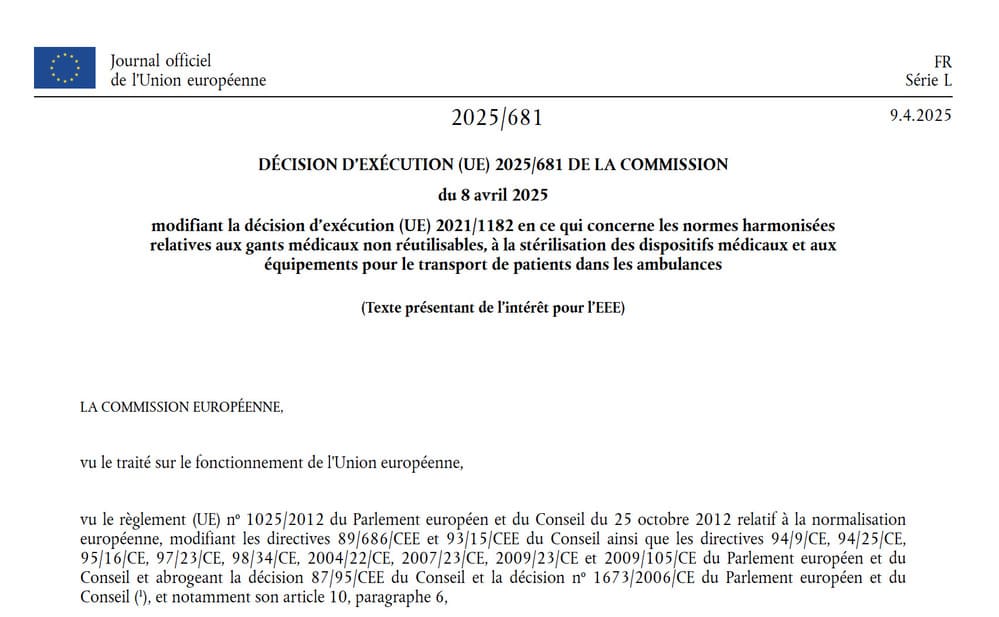
MDR harmonized standards: April 8, 2025 update, what manufacturers need to remember
Medical devices regulation
In a regulatory world as fluid as that of CE marking for medical devices, the publication of new harmonized standards deserves your full attention. On April 8, 2025, the European Commission adopted Implementing Decision (EU) 2025/681, amending the list of harmonized standards applicable under Regulation (EU) 2017/745 (MDR).
This text, although technical and little commented, has concrete consequences for manufacturers. In particular, it concerns three families of frequently encountered products or processes: single-use medical gloves, device sterilization and ambulance equipment for patient transport.
Here's what you need to bear in mind, and especially what it means for your technical files.
1. Reminder: what is the purpose of a harmonized standard?
A harmonized standard is a European standard whose reference is published in the Official Journal of the European Union. When a manufacturer applies a relevant harmonized standard in full, he enjoys a presumption of conformity with the requirements covered by the MDR.
In plain English: if your technical file is based on these standards, you don't need to demonstrate yourself how you comply with certain points in Annex I of the MDR. This saves time... and provides a safety net in the event of an audit or CE assessment.
Be careful, however:
- A harmonized standard is never mandatory,
- But if you don't use it, you'll have to demonstrate, with solid arguments, that your solution is at least equivalent.
Finally, applying an old version of a harmonized standard that has been superseded may expose you to remarks from the notified body.
2. What Decision 2025/681 changes
The decision amends the annex to implementing decision (EU) 2021/1182 by adding 6 new harmonized standards, some of which are updates of existing standards. Here is the summary:
Harmonized standards added to the Official Journal
|
Reference |
Subject |
Key evolution |
|
EN 455-1:2020+A2:2024 |
Disposable medical gloves - Hole detection |
Addition of enhanced detection requirements |
|
EN 455-2:2024 |
Single-use medical gloves - physical properties |
Mechanical testing updated |
|
EN 556-1:2024 |
Sterilization - terminally sterilized devices |
Revision of validation requirements |
|
EN 556-2:2024 |
Sterilization - aseptic processing |
Clarification of performance criteria |
|
EN 1865-2:2024 |
Ambulance equipment - motorized stretchers |
Harmonization with recent safety requirements |
|
EN 1865-6:2024 |
Ambulance equipment - motorized chairs |
New standard, MDR support |
These standards came into force on publication in the Journal Officiel on April 9, 2025.
3. What are the implications for DM manufacturers?
Case study 1 - Manufacturer already applies EN 455-1:2020
He must compare the addition of amendment A2:2024 and check that his quality controls comply with the new version. If not, an update of the inspection plan and technical file is required.
Case study 2 - The manufacturer was still using a pre-MDR standard
The risk is real. The use of a MDD (non-harmonized MDR) standard gives no presumption of conformity. An audit may require detailed justification.
Case study 3 - The manufacturer ignores this update
In a post-market surveillance context, a problem with gloves, sterilization or transport equipment could expose the company to legal or insurance consequences, especially if a harmonized standard was available but ignored.
4. Mini FAQ
Can I continue to use a previous version of a harmonized standard?
No, unless it is still listed in the Official Journal. As soon as a new version replaces an old one, the latter loses its harmonized status.
Do I have to review my entire technical file?
No, but you do need to assess the impact of each new version on your products. This can take the form of a simple watch note, or an update of the STED/Annex II-III.
Is it retroactive?
No. DMs already on the market are not affected, but any modification, renewal or new declaration must be made using the updated standards.
How can I be notified of future updates?
By following the updates to Decision 2021/1182, available online via EUR-Lex, or by using a delegated regulatory watch (like the one offered by CSDmed).
Can I freely access these standards now?
Not yet, but the CJEU recently recognized in case C-588/21 P that there is an overriding public interest in allowing access to harmonized standards. This point could change the conditions of access in the coming months.
5. Integrating standards into your quality strategy
Harmonized standards are more than just technical references. They are at the heart of your MDR compliance, and updating them should be anticipated rather than imposed.
At CSDmed, we help manufacturers to:
- Monitor these changes in standards,
- Analyze their impact on existing products or those under development,
- Update technical files in a coherent and well-founded manner.
Need support with your standards, compliance reports or validation protocols?
Contact us, and let's move forward together.
6. Related resources
- Understanding the legal scope of harmonized standards (coming soon)
- MDR CE marking: pitfalls to avoid when you're a start-up
- ISO 14971 and start-ups: how to get started on risk analysis without getting lost
- FDA vs MDR: 5 differences that count for a DM manufacturer